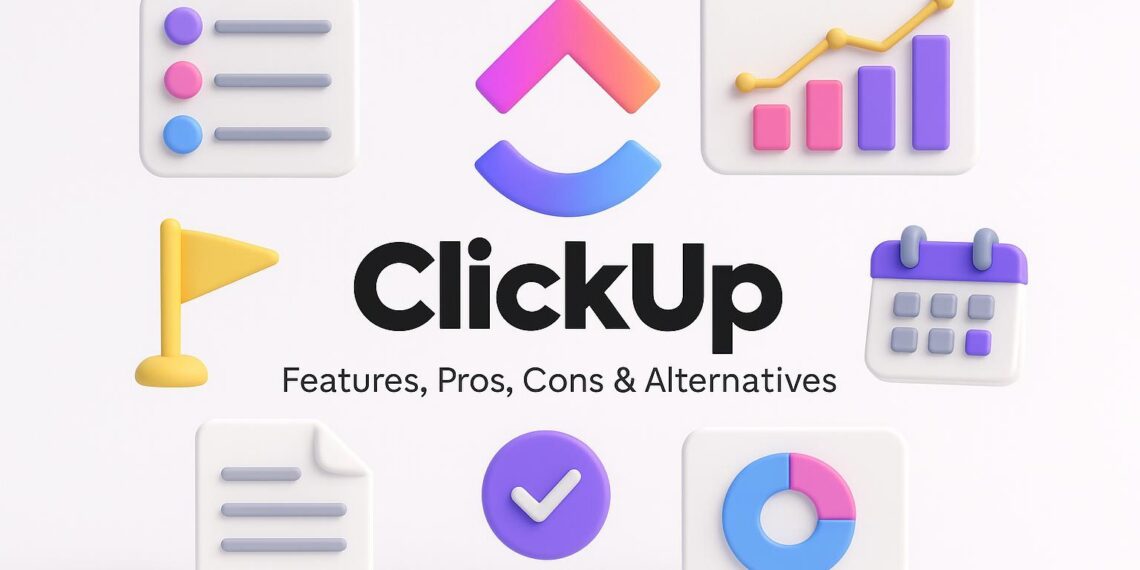Ever felt like your startup is drowning in too many tools—one for tasks, another for docs, something else for sprints and yet another for chats? 👩💻 If your team spends more time switching tabs than actually building, you’re not alone. Founding teams are notorious for tool sprawl, and it kills speed, focus, and, let’s be honest, morale.
ClickUp promises to end the chaos by packing all your project management and collaboration needs into a single platform. But can it actually become your startup’s operating system, or will the complexity be more hassle than help? In this founder-focused review, we’ll cover what ClickUp actually is, its top features for startups, price points, real-life pros and cons, smart buying questions, and how it compares to crowd favorites like Asana and Notion. Let’s get tactical. 🚀
Overview
ClickUp bills itself as the “one app to replace them all,” and for startups juggling execution across product, marketing, sales, and ops, that’s a bold claim. Launched in 2017 by Zeb Evans and Alex Yurkowski, ClickUp has grown from a scrappy upstart to a powerhouse—mainly because founders and fast teams want one customizable tool that won’t force them to migrate again in 18 months.
What makes ClickUp different? Its radical flexibility. You pick your own workspace structure, views, automations, and even toggle features per team via “ClickApps.” For startups, that flexibility means you’re not stuck with someone else’s workflow—you build your own, evolve it, and scale as you grow, all in a single, central hub. From pre-seed idea sprints to Series A hiring spreadsheets, it aims to be your nerve center 🧠⚡.
Key Features of ClickUp
ClickUp isn’t short on bells and whistles—but what really counts for startups is what helps you move fast without breaking your flow. Whether you’re trying to ship features, onboard hires, or wrangle marketing and ops in one place, these are the tools that make it founder-friendly. Here’s what actually matters to founders building and scaling fast:
🦤 Customizable Hierarchy
Build your workspace your way—from Company > Team > Project > Task > Subtask, or as simple as a single board. Scale from “just founder and CTO” to “cross-functional teams” with zero migration.
👁️ Multiple Project Views
Switch between Kanban, List, Gantt, Timeline, and Table views in one click. Designers love the visual Boards, PMs obsess over Gantt, and devs get calm, no-nonsense Lists—everyone’s happy.
🛠️ Deep Task Customization
Tasks can have custom fields (status, priority, budget, client, attachments), dependencies, recurring schedules, comments, threaded discussions, and @mentions—a proper upgrade from sticky notes or Slack todos.
📄 ClickUp Docs & Knowledge Base
Built-in Docs for meeting notes, product specs, SOPs, or your startup wiki. Link docs directly to projects or tasks; the entire company’s knowledge is findable (unlike old Google Drive mazes).
🎯 Goals & OKRs
Need to run like a high-output startup? Set company goals, sub-goals, and KPIs inside ClickUp, automatically track progress from linked tasks—great for “Are we hitting growth?” clarity.
⚡ Automations
Automate repetitive chores (e.g., assign review tasks when card moves to “QA”) with no-code logic. Less admin overhead, more time building. Connect to 1000+ apps via Zapier/Make if you outgrow basic built-ins.
🤖 ClickUp AI (Optional Add-on)
Auto-summarize threads, generate reports, or spark brainstorms—all without leaving your workspace. Saves time when you’re wearing too many hats.
📈 Dashboards & Reporting
Custom dashboards show burndown, workload, sprints, time tracking, and more—vital for keeping investors/calendars happy. Even early teams can see bottlenecks before they cause trouble.
🔐 Integrations Galore
Connect Slack, GitHub, Google Calendar, Figma, Zoom, and more natively; or use the open API for wild custom workflows.

ClickUp Pros and Cons
Startup life is about trading off speed, control, and simplicity. Here’s how ClickUp stacks up:
👍 Pros
- Extreme flexibility: Adapt ClickUp to your evolving workflow, not vice versa.
- All-in-one value: Docs, sprints, tasks, calendars, chat—ditch 3+ subscriptions.
- Generous free plan: Start with no credit card, upgrade only when complexity or team size demands.
- Real-time collaboration: Perfect for async/hybrid teams scaling fast.
- Scalable: Won’t outgrow it if you hit product-market fit and suddenly hire 10 more folks.
- Rapid development: New features drop often—startup-culture vibes.
👎 Cons
- Steep learning curve: You’ll need an ops lead or a highly-motivated founder to shape it right.
- Can feel overwhelming: Too many features could distract early-stage teams if not disciplined.
- Performance: Large workspaces or heavy automations may lag (teams of 20+ doing everything in ClickUp, beware).
- UI inconsistencies: Some modules feel less polished—“docs” can lag compared to Notion.
- Mobile app underwhelming: Best for simple checks, not full PM in your pocket.
- Add-on fees: Advanced AI costs extra per seat.
## Considering ClickUp for Startups
Founders choosing a project management platform face a balancing act: flexibility vs. simplicity, scalability vs. speed. ClickUp might look like overkill at first glance, but for the right team, it can replace half a tech stack. Choosing the right platform is about your current and target state. Ask yourself:
📊 How complex are your workflows?
If your ops involve sprints, OKRs, multi-team collab, Docs, and roadmaps—ClickUp shines. For just task lists? Maybe overkill.
💰 What’s your realistic budget?
Zero burn? The free plan is solid. As soon as you need guest access, advanced dashboards, or automations, it’s upgrade time.
🔗 What other tools must it integrate with?
If you rely on Slack, GitHub, Figma, or Google Suite, ClickUp’s integrations save context switches. Need unique integrations? Check API access early.
📈 How fast will your team grow?
Plan for where you want to be in six months, not just the next sprint. ClickUp can scale—provided someone manages the sprawl.
🧑💻 Who’ll be the internal admin or “ClickUp champion”?
To maximize ClickUp (and reduce cognitive overload), someone should own the initial setup and onboarding.
🚡 How vital is customization?
If founders bristle at inflexible platforms, ClickUp lets you rebuild processes whenever you pivot.
🧠 Does your team hate learning clunky new tools?
If “new tool phobia” is rampant, start with the simplest setup—avoid feature sprawl early, or adoption will tank.
🚥 How much process do you really need?
Startups under 3 people can run on basics; don’t let ClickUp become your full-time job before it’s justified.
ClickUp Plans and Pricing
| Plan Name | Monthly Price (Annually) | Usage Limit | Key Features |
|---|---|---|---|
| Free Forever | $0 | 100MB storage, 100 CFs, Limited Dashboards | Unlimited tasks/members, basic Docs, 3 Whiteboards |
| Unlimited | ~$7/member | Unlimited storage & Dashboards | Guests, Gantt, Time Tracking, Integrations |
| Business | ~$12/member | Advanced automations & reports | Advanced Time Tracking, SSO, enhanced security |
| Enterprise | Custom | Highest, white-label, HIPAA | Dedicated manager, custom permissions, API |
Note:
- Annual billing = cheaper by 20–45%.
- AI features are paid add-ons (~$5/member/mo).
- Upgrade triggers: Outgrow storage, need more automations, or teams above 5 folks with complex needs.
## ClickUp Startup Discount or Promo Info
🚨 No broad “startup discount” or AWS-level credits—but:
- Generous Free Forever: Unlimited tasks/users (with usage limits), perfect for pre-revenue or MVP teams.
- Annual discount: ~20–45% savings if you pay yearly—great if you’ve raised or want long-term savings.
- Partner promos: Sometimes available via accelerator/VC partner programs. Always worth asking!
- Nonprofit/Education discount: Available for eligible orgs.
Tip: For most early-stage startups, the free plan or Unlimited tier covers 90% of needs. Upgrade when your workflow or team size clearly demands it—not before.
## Comparing ClickUp with Alternatives
Founders debate: ClickUp or Asana? Monday? Notion? Here’s a quick tactical snapshot—adapt row headers to real founder concerns:
| 🧹 Feature | ClickUp | Asana | Notion |
|---|---|---|---|
| 🏱 Free tier | Yes, generous (most features, 100MB) | Yes (15 users, limited features) | Yes (basic block/database limit) |
| 🏗️ Customization | Extreme (views, fields, status, Docs) | Moderate (custom fields, templates) | Unmatched (block/database, but less built-in PM) |
| 📊 Reporting | Built-in dashboards, workload, time | Dashboard/portfolios on paid | Roll your own (wikis, OKR tables) |
| 🔌 Integrations | Slack, GitHub, GDrive, API, Zapier | Slack, Zapier, GDrive, more | Slack, Zapier, API, limited natively |
| 🤖 AI Features | AI add-on: summarize, write, generate | Basic AI via integrations | Notion AI includes writing, summarize, autofill |
| 🏢 Hierarchy | Workspace>Space>Folder>List>Task | Workspace>Project>Task | Workspace>Page>Subpage>Database |
| 🔒 Guest Access | Paid: guests with permissions | Paid: limited guest roles | Paid: unlimited guests, page share |
| 🌟 Best for | All-in-one hub, agile founders scaling fast | Teams wanting easy task/project mgmt | Docs/wiki builders, founders who want a “home-grown” system |

FAQs
❓ Is ClickUp beginner-friendly?
Somewhat. Task tracking is easy, but the rabbit hole of features means you should start simple and layer complexity only as you grow.
❓ What are the hidden costs?
AI, advanced automations, and guest permissions are extra. If you scale team size or want analytics, you’ll hit paywalls beyond Free/Unlimited.
❓ How steep is the learning curve?
High if you want the full toolset. Assign a ClickUp owner to avoid setup chaos (or risk end-user revolt).
❓ Mobile app—good enough for founders?
Fine for reviewing/checking tasks on the go. Not ideal for major project planning or managing workflows on mobile.
❓ Can it replace Jira/Asana/Notion for a product team?
Yes, for most early-stage to mid-size teams. Unless you need ultra-specialized dev workflows, ClickUp’s sprints, docs, and integrations fit startup devs.
❓ What’s “unlimited users” on Free really mean?
No per-seat charge, but guests have limited access. Upgrade for granular guest permissions or role management.
❓ Is there a public startup program for big credits?
Not widely—lean on the free plan or annual discount, unless your accelerator has a deal.
❓ How hard is it to migrate existing data?
Imports supported from most big tools (Trello, Jira, Asana, CSV). Plan 2–4 hours for setup/testing if you’ve lots of legacy data.
Final Thoughts
ClickUp offers founders that magic mix: flexibility, depth, and initial affordability for organizing work as you dream big and scale fast–all in one place. If your startup juggles shifting product specs, investor asks, onboarding, and a mountain of to-dos, it can be a gamechanger, eliminating tool chaos and putting your entire team on the same page (literally and figuratively) 📈🚀.
But take it from founders who’ve been burned by too much power: ClickUp’s complexity must be wrangled. Assign a product-minded owner, start small, only layer features when truly needed, and don’t be afraid to pivot your setup every quarter. ClickUp won’t be the lightest lift for “just shipping” teams seeking super-minimal tools, but if you’re building a durable, scalable company—or want to avoid tool migration pain in 12 months—it’s a top pick.
Next steps?
- Spin up a Free Forever workspace and stress-test it with your real workflows.
- If it clicks, bring the rest of the team on.
- Not the right fit? No sweat! Asana and Notion are stellar, too—just optimize for your real pain, not hype.
Startup verdict: If you want to run your whole company from a single cockpit as you scale, ClickUp is a founder’s friend—just add discipline and a touch of setup love. 🌟💡










